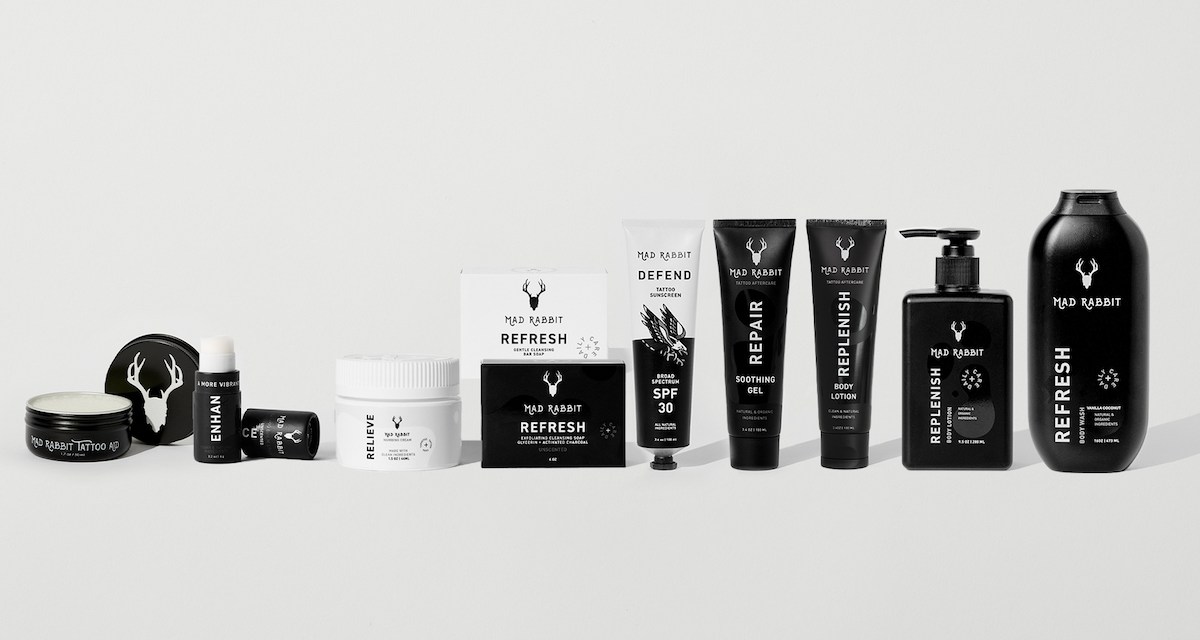Inside Mad Rabbit’s ambassador marketing strategy

Mad Rabbit, a tattoo care brand that sells products such as balms and body washes, is reaping the rewards of its ambassador program.
Mad Rabbit, which launched in 2019, has encouraged customers from the get-go to show off their tattoos and Mad Rabbit products on social media, co-founder Oliver Zak told Modern Retail. However, it wasn’t until two years ago that Mad Rabbit created a more formal ambassador program. In the past year and a half, that program has ballooned from 3,000 members to nearly 8,000.
There is a low barrier to entry; although Mad Rabbit considers applicants’ social followings, it aims to accept anyone who is a fan of the brand, Erin Murray, svp of marketing at Mad Rabbit, told Modern Retail.
A majority of Mad Rabbit’s ambassadors are not tattoo professionals, although some 800 are tattoo artists and apprentices. Participants get a variety of perks, including first access to new products, a trip to Mad Rabbit’s headquarters in Los Angeles and participation in focus groups. Ambassadors can participate in the program in three ways: through an affiliate model; through completing social media challenges for points, cash or rewards; or, both. About 75% of ambassadors do both, and in the past year, ambassadors have generated nearly $500,000 in revenue for Mad Rabbit.
Mad Rabbit had a $56 million valuation as of March 2023. The brand first began as an online-only company but now sells at major retailers including Walmart and GNC.
Beyond being a revenue channel, Mad Rabbit also treats its ambassador program as a talent and hiring pipeline of sorts. It’s accomplished this through building an additional two tiers for tattoo artists: “sponsored artists” (who Mad Rabbit sees as making top-tier content) and a “pro team” (some of the top tattoo artists in the United States). The sponsored tier has about 60 people, while the pro tier has about 15, Murray said.
In order to be a sponsored artist, a tattoo artist has to go through an application process and have Mad Rabbit review the quality and style of their work. Once given the green light, sponsored artists can then tattoo at events alongside Mad Rabbit employees and receive “a ton of free product and other deliverables,” Zak said. Then, he said, “The hope from there is, after spending a year on the sponsored artists team, they then graduate to the pro team, which is a paid position, and they’re very much so figureheads of our brand.”
While Mad Rabbit wants to grow its ambassador program as a whole, it’s particularly focused on boosting its sponsored artists segment. “We’re trying to make [the program] increasingly immersive, especially as we expand into retail and go deeper into doing live events,” Zak said.
Brands in all sectors — but especially consumer goods — are increasingly relying on ambassador programs to get the word out about their products. According to eMarketer, 83% of marketers will work with influencers this year, a number that will surpass 90% in 2027. EMarketer also predicts that influencer marketing spending in the U.S. will increase 16% this year to reach $8.14 billion.
A well-constructed ambassador program can be crucial for connecting with a brand’s desired audience, Sky Canaves, senior analyst of retail and e-commerce at eMarketer, told Modern Retail. “The word authenticity tends to get over-used, but when it comes to creating ambassador programs that resonate, it’s really critical for brands to tap into their real-world fans — those who use their products and are passionate enough about them to talk them up naturally,” she said.
Today, many ambassador programs invite their members to be active participants in decision-making. Bubble asks its ambassadors to weigh in on product names and packaging, while Claire’s relies on ambassadors to help with in-store events and photo shoots. Both these brands appeal to younger audiences — demographics that want to see real interactions between companies and consumers, Sarah Engel, president at the digital media company January Digital, told Modern Retail. She recommends that all brands looking to resonate with Gen Z or Gen Alpha “strongly consider” ambassador programs.
Still, it’s important for brands to stay disciplined with their ambassador programs, Kimberley Ring Allen, founder of Ring Communications and adjunct professor at Suffolk University, told Modern Retail. Rather than recruit a wide-ranging group of ambassadors who may put little effort into the program, she said, brands should bring on people who believe in the brand and have a personal attachment to it.
Mad Rabbit’s decision to use tattoo artists as ambassadors falls into this second bucket, Allen said. “At the end of the day, you want to believe that this person who is telling you about this product… has first-hand experience and knowledge in it,” she told Modern Retail. “If the ambassador comes across as overly promotional, it’s not going to work.”
